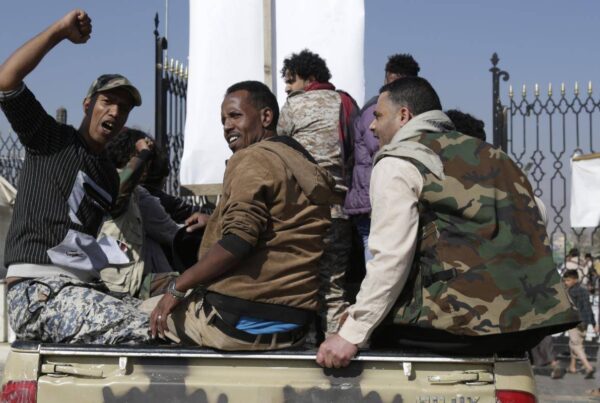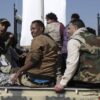“If we seek a country in which Nuaman al-Hudhayfi is equal to President Abed Rabbo Mansour Hadi, then we must rid ourselves at once, and from this chamber, of racism.” So spoke the representative of the “marginalized Yemenis” at the National Dialogue Conference in March 2013. The peaceful youth revolution in Yemen that broke out in February 2011 has broken many barriers, sundered many chains and changed many minds. It is the first Yemeni revolution that originated in, and depended upon, peaceful protests. In contrast to what has been the norm throughout modern Yemeni history, this revolution did not originate in some secret organization or military coup; neither did it fall under the total control of one particular political faction.
The barrier to women voters
Participation by Yemeni women in the country’s political life still runs primarily one of two ways. The first is an ornamental route — employed with equal frequency by the government and the other political parties — whereby they reserve some nominal roles for women in order to demonstrate their support for women’s rights. The latter route has been taking place on the ground, and is mostly limited to organizing women voters to turn out for their parties’ candidates in the parliamentary or presidential elections.
In this latter respect, the Islah Party (the Yemeni Muslim Brotherhood) has enjoyed greater success than the other parties. And they have at least experimented with nominating some of their female members as candidates for the elections. Still, it was a rare occurrence for one of them to actually win. Due to the event, the current Yemeni parliament has but a single, lone female member: Oras Naji.
Tawakkol Karman of the Islah Party is considered the most prominent female leader of her party to dissent from its view regarding the proper role of women. Despite the widespread international admiration toward her, she is a bitterly controversial figure within Yemen. She founded and administers a private NGO and participates in many protests alongside men. Yet, she did not become a leadership figure among the public until the dawn of the revolution more than two years ago, when she pitched her tent in Change Square in Sanaa alongside dozens of other tents filled exclusively with men. She led youth protests demanding the fall of former Yemeni President Ali Abdullah Saleh’s regime, even though her party’s most far-reaching demands at the time never went beyond “reforming the regime” (that is, before they hopped on Karman and her companions’ bandwagon in demanding its overthrow). Her (admittedly hours-long) arrest was a rare occurrence in Yemen, a country where women normally enjoy social immunity even from the police and where the security services would not normally dare to detain a woman in this manner.
As a result, Karman won the Nobel Peace Prize a few months after the revolution began — the first Arab woman to do so. She toured around the world to introduce people to the revolution in Yemen. She broke the mold of conventional women’s roles, that of a soft-spoken mother, by directly engaging in revolutionary politics despite the very real dangers of doing so. As a result, Karman is now a globally recognized figure — something that she would not necessarily have been were it not for the recent revolution.
Bushra al-Maqtari played a similar role in Freedom Square in the city of Taiz. Indeed, she may have been even more daring in her speeches, which drew on the legacy of the revolutionary Left. Maqtari belongs, after all, to the progressive Yemeni Socialist Party, which is more openly supportive of women’s rights. Maqtari was subjected to campaigns of slander and excommunication by extremist Islamist leaders, including those who hopped on the new revolutionary bandwagon. Yet, she continued to preach her progressive revolutionary views without pause. Maqtari never entered into permanent political alliances, which might explain why she does not enjoy the media presence afforded to Karman, who possesses stronger political ties with more traditional elements, despite her own, more progressive-leaning activism.
Arwa Uthman and Amal al-Basha have both endured their share of defamation and more, as the first and most profound symbols in terms of their vision of female activism. First Armored Division soldiers led by Maj. Gen. Ali Muhsin, one of the highest ranking army leaders to defect from Saleh, assaulted Uthman when she participated in mixed demonstrations during the revolution.
Uthman, Maqtari, Basha and many other women still engage in revolutionary activism against the same revolutionary forces with whom they once participated: namely, against the traditional forces that have attempted to marginalize the most prominent figures of the revolution — those people who brought the revolution to power. This is another instance of their pioneering stance as revolutionary women, and not merely rebellious ones. In other words, their revolution is against injustice as such, regardless of its source; they are not simply rebelling for some temporary goal. Moreover, 30% of the seats in the National Dialogue Conference are held by women (according to a fixed quota). This represents another of their victories — another product of the revolution. It was even higher than the ceiling of their earlier demands for political representation guaranteed by a parliamentary quota of 15% of seats reserved for women.
Breaching the wall of family decision
It is well-known that the Yemeni family is one of the most central components of society. It acts as one bloc: its senior member represents it, and he makes the major decisions in the family’s name. But the youth revolution broke the family’s monopoly over all the decision making of all its members when individual family members took divergent stances toward the revolution. Abu Dharr Najl Abdo al-Jundi (the spokesmen for the last Saleh government, and currently the spokesman for his party as well as the Deputy Minister of Information) disavowed his father’s pro-Saleh position through the national press. He publicly expressed his support for the revolution, and in particular its Islamic segment. That public stance became one of the signs and portents of change, particularly with the wide media circulation it received.
The same story repeated itself with many other Yemeni families, even if they could claim no media presence. It constituted a major leap toward individualistic decision making, outside the framework of the family. The same phenomenon also took place at the tribal level — that basic organizational unit in Yemeni society known for being obedient to the commands of its sheikh, and only rarely daring to disobey him.
Coexistence and cultural pluralism in the city square
Previously, a warm coexistence reigned between different parties that had, for a long period, dealt with one another as adversaries, both as groups and individuals. Loudspeakers in the revolutionary squares carried voices reciting the Holy Quran as well as the songs of famous Yemeni artist Ayoub Taresh; religious sermons comingled with Leftist thinkers; the advocates of a secular state and the heralds of an Islamic Caliphate shared a single platform and spoke to a single public. All this carried on despite attempts by a certain movement to monopolize the platforms of the squares.
In one tent, one man would spend the night offering prayers and supplications (with music forbidden), while in the tent next door his neighbor passed the evening listening to Fayrouz and Umm Kulthum. Each side accepted the other, and sought each other out in the daytime to break bread together. Their unity of purpose brought them all together, lifting them above their petty differences in an almost cosmic elevation that few had previously been able to achieve.
The Islamists called for a civil state and women’s participation, just like the Leftists and the liberals; the nationalists adopted a less narrow view of the traditional (reactionary) discourse which they had always held responsible for the country’s backwardness.
Rich new networking opportunities
There are not many opportunities for Yemenis to meet one another other than khat-chewing sessions, at the office, or the occasional chance meeting in a restaurant or an airport. That is, until everyone met in the squares for months on end, creating a fertile new environment for the youth to come to know one another. Friendships were formed here, some of which changed the course of their participants’ lives, both practically and intellectually. But the more intimate relationships are the legitimate marriages that resulted; a “revolutionary wedding” is something without precedent in Yemen, yet just such relationships took root among some male and female protesters.
The extraordinary carnival of talent among artists of every kind found no home outside the squares of the revolution. Even culinary recipes were exchanged among those female pioneers of the square who enjoyed freedom of movement without restriction or harassment [for the first time] in a society where mingling with men almost never occurs except within the home.
Shoulders without weapons
It is well-known that weapons are the faithful companion of Yemeni tribesmen, especially those coming from remote areas. But this warm relationship began to dissolve on the outskirts of the squares. The tribesman laid down his weapon and came to protest alongside his like-minded civilian compatriot, thus achieving voluntarily what years of attempts at banning weapons could not.
Historically, the tribes surrounding Sanaa entered the city to loot and plunder whenever the opportunity was ripe. But in the latest youth revolution they played a different role, offering to feed the young protesters, to say nothing of the tribal youth’s own participation in nonviolent protests. Likewise, blood vengeance, an all too common phenomenon, was absent both from people’s minds and their rifles during the period of the revolution. A man would meet his rival and both would proceed on their way, without the slightest attempt to assault the other or to exploit an opportunity for easy revenge.
The need to stay in contact
Social networking sites have garnered unprecedented participation from Yemenis recently. They have extended their reach even into far-flung villages, since the local inhabitants desire to preserve their new friendships, and Facebook and Twitter are the best available means for them to do so. These websites have also been an ideal method for spreading calls to convene in the central squares in the event of any future activity.
Political analysts and journalists, veteran activists newly transformed into media stars as well as political campaigns and initiatives — the city squares were the first seed for all of them. Among them was the “Forcibly Disappeared” campaign, adopted by the artist Murad Sabi’a and a number of his colleagues. They drew their faces on the city walls to remind the inhabitants of the disappeared, and to demand that their fate be revealed. Another initiative was to boycott khatt (a domesticated plant widely used to excess by Yemenis). These and other creative initiatives might never have been conceived by their proponents before they came to the squares — and even if they had, no one would have been able to execute them. Certainly not the forcibly disappeared.
Mohammad al-Emad is a talented youth who continued to photo-document the revolution for months on end using a camera borrowed from a friend (he neither possessed one of his own nor could he have afforded to buy one). One upload of his photos onto Facebook by a third party was enough to organize a campaign to buy Emad a high-resolution professional camera.
Nadia Abdallah is another photographer, one who dons the niqab [the Islamic veil covering a woman’s face and body], whose lens captured some of the most stunningly expressive photos of the revolution. A female photographer in Yemen is as rare as water in the Sahara.
These are modest snapshots of what was created in the squares of the youth revolution. They are not minor things; they attest to a profound societal change in the making, one that has found its soil and is beginning to grow.
Alertness and tolerance without limit
“For the sake of a safe and prosperous country — one filled with love, justice, tolerance and equality between all its children — and despite the pain and sadness of having lost our glorious son, we hereby forgive the killer, that sniper who fired the killing bullet which pierced Nizar al-Ghass’s heart. We beseech God to forgive him and to clear him. Because I understand that he is now suffering from post-traumatic depression, I beseech God to descend through His Divine Presence to soothe this man’s heart, to fill it with peace and tranquility; I pray that He guides this man to spend the remainder of a long life working to help others.”
The passage highlighted above appeared in a speech given by Nuaman al-Hudhayfi, the representative of “the marginalized Yemenis” (Yemen’s black citizens) at the National Dialogue Conference. None of them had ever participated in any political activism or held high office, for as a class they are considered one of the lowest rungs on the Yemeni social ladder. In many ways, their stature resembles that of the untouchables in India. As for the above paragraph, it is quoted from an article in the press by Ha’il Salaam, in which he eulogized his son Nizar (17 years old) who fell as a martyr in May 2011, while participating in a march on Al-Zira’a street in Sanaa. Its incredibly human and patriotic content requires no explanation in a society in which vengeance-killings takes hundreds of lives every year.
These social transformations have appeared in Yemen over the course of the last two years because of the revolution. The revolution supplied Yemeni people with their values and their environment. These transformations may have impacted the average Yemeni even more than the political results of the revolution, at least thus far. This change has been real even if, by definition, it remains fragile and reversible. It must be preserved. For if it takes root, the gain will be beyond measure.
Farea Al-muslimi is a Yemeni youth activist, writer and freelancer. His writings have appeared in Al-Monitor, The National, Foreign Policy, Assafir and many other regional and international media outlets. He tweets at @AlMuslimi.







